The Ultimate Guide To Trimming Your Natural Hair At Home
Us naturalistas can agree that hair growth and length retention are constant goals we strive for on our life-long hair care journey. However, some of us become too attached to our hair that we want to hold on to all of it, every bit of it including the thin, fragile see-through ends. With the new year in sight, it’s time to get rid of the dead weight. As they say, out with old and in with the new. To keep safe and let’s be honest save some cash, we’re gonna teach you how to safely trim your hair at home.
With our helpful tips and tutorials, you’ll steer clear of any major fails or embarrassing cuts. Read on as give you the inside scoop on trimming your damaged ends and maintaining healthy hair for once and for all.
Key Signs That It’s Time For A Trim
You will know it’s time for a trim when you start experiencing the following signs:
-
Fairy Knots or Single Strand Knots
One of the obvious signs that a trim is needed is that it has become more difficult to detangle your hair. Wash day becomes more stressful and fairy knots get the best of you. According to Naturally Curly, fairy knots occur when single strands of hair knot together and subsequently create bigger knots. A trim will serve as a solution to this problem and prevent further breakage.
-
Split Ends
Ah, annoying, inescapable split ends. With constant manipulation, excessive heat, and other harmful hair habits, split ends can wreak havoc on your hair. Getting seasonal trims will help you avoid this issue.
-
Frizzy Dry Ends
Remember those times when you did a twist-out and braid-out and no matter how much curl cream you put on your ends it remained super frizzy and barely curled. Yeah, then it’s probably time for a trim.
-
Excessive Breakage
How about those moments when detangling or combing your hair and you notice that short pieces of hair are falling out, like excessively. You know the drill – it’s time for a trim!
2 Effective Ways To Trim Natural Hair At Home
Before you start trimming your hair, you need to have the right equipment. And by equipment, I mean a wide-tooth comb and hair shears, and not the scissors you use to open a box or cut paper. Why? Because paper scissors are not sharp enough which can result in uneven ends that are more susceptible to damage. Hair shears are sharper and will give you a more precise cut. You can shop for quality hair shears at a store online.
Another quick tip when trimming your natural hair at home is to cut on dry stretched hair. You may be used to a salon curly cut or the curl by curl method but those cuts require incredible precision and skill. Leave that to the professionals and cut dry.
Now that you have your shears in hand, here are two trusted methods to effectively trim your hair.
1. Blow-Dried/Stretched Hair Method
To get an even precise cut, stretch your hair first using a blow dryer. If you prefer to not use heat, try a chunky braid out or a heatless roller set like Curlformers first to effectively stretch your curls.
Next, part your hair in sections and lightly detangle using your wide-tooth comb as a guide. Once your comb meets an inch or so towards the ends of your hair, use your hands to hold that position in place and trim where you begin to spot the dead, frayed, thinning ends of your hair.
Need to see this technique in action? Check out our trimming tutorial below.
2. Two-Strand Twist Method
A simple, easy method to trimming natural hair is the two-strand twist method. This method is great for dusting your ends and if cutting your hair worries you. All you need to do is to create two-strand twists (smaller twists will lead to a more accurate cut.) After your hair is fully dry, cut your frizzy, thinning ends in a diagonal slant. Voila, a quick dusting that will get you by until you can receive a professional trim at the salon.
How Often Should I Trim My Hair
Experts recommend that you should trim your hair every three months. Trimming your hair routinely will help you retain length and reduce breakage. Once you trim every three months, you’ll notice that your hair will be healthier and that you will need to cut less hair over time.
Enjoyed this post? Share your thoughts with us in the comment section below.






Leave a comment